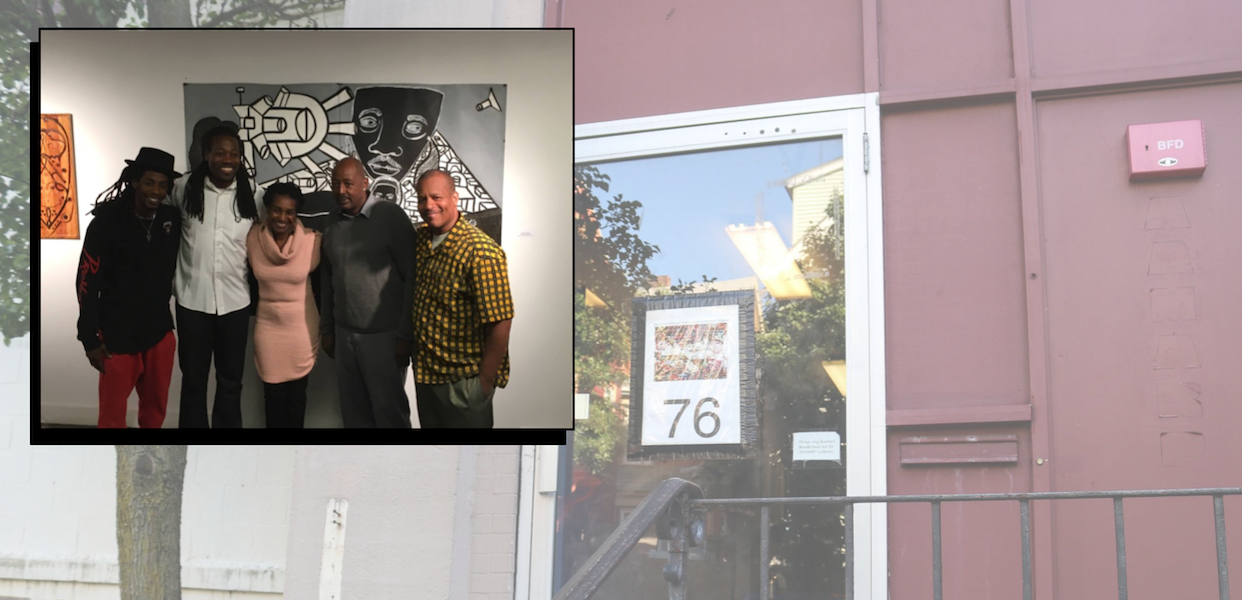In region’s latest mass eviction, Northeastern boots African-American creatives from JP space
On the corner of a quiet street in Jamaica Plain is a brick building that houses the studio for the African American Master Artists in Residence Program. The program is affiliated with the Northeastern University Department of African American Studies and has provided critical free work space to AAMARP talent for 40 years.
But now the artists face an uncertain future.
Maria Cimilluca, vice president for facilities at Northeastern, wrote a letter dated June 28 to AAMARP leader Gloretta Baynes asking all AAMARP artists to vacate their studios, located at 76 Atherton St. in JP, by July 13. In the letter, the administrator suggested that the artists in the space contributed to the building’s deterioration: “We understand that this news may disappoint you and others, but given the deteriorated condition of the building, and the derelict way that some of the users/occupants have abused the space, we have no alternative to the planned approach.”
In the time since their eviction note arrived, discussions have led to Northeastern extending the move-out date to July 31, and offering to assist with heavy lifting. But in initially informing tenants that they have two weeks to remove all of their work and vacate, some say that the university acted swiftly and unreasonably, even removing the AAMARP page from the university’s website.
If considered in a vacuum, this purging of creatives—and artists of color, no less—would seem bad enough to those who wish to keep urban communities eclectic and vibrant (as of last month, a dozen artists were using the building). But this eviction is merely the latest in a recent string of such noteworthy displacements, such as the EMF building in Cambridge, the Piano Factory in Boston’s South End, and the Taza Chocolate Factory in Somerville. The JP ouster has been perceived by some as a particular blow to the African-American artist community and artists of color, which also reflects national trends. According to a 2015 study from the University of Maryland, arts programs of color are particularly vulnerable, with “many leading arts organizations of color suffering from chronic deficits, with nearly half of the nation’s 20 largest arts organizations of color surveyed running deficits of at least 10 percent of their total annual budgets.”
Shea Justice, an illustrator and activist who joined the program in 2003, called the situation “sudden and traumatic,” saying that the news came without any precedent or warning.
“There hadn’t been any incidents recently,” Justice told DigBoston. “There have been some in the past, but there haven’t been any situations to bring on this sudden bum rush to just kick everyone out.”
***
Justice said that artists have been reaching out to Northeastern for repairs for years.
“We’ve asked for over a year for Northeastern to please fix it so that the place is handicap-accessible,” Justice said. “They never did.”
The artist added that, among other offenses, Northeastern neglected to shovel during the winter: “If there’s any issue with the building, ‘Oh, this isn’t right, or these things aren’t functional, and this thing’s falling apart,’ to put that blame [on the artists] is just simply untrue.”
Don West, a photographer who’s been with AAMARP for 20 years, also said that he was wary of Northeastern’s reasoning that artists wrecked the building.
“They purported we had committed infractions on the structure of the building and that they were concerned about the safety of people in the building, etc. The so-called infractions that they outlined were issues that had come up in the past and we had addressed them. Some of them were inaccurate. Some of their views about our relationship to the building and the program were inaccurate.”
Asked about the school’s relationship and communication with AAMARP artists, and about repairs and the requests that tenants say they made for fixes, Renata Nyul, vice president of communications at Northeastern, said, “Over the years, multiple times, the university has reached out to the artist leadership to warn them about misuse of the space and to let them know how it compromises safety. … Just so you know, the issues of safety and security over the years range from incidents involving police activity, police having to be called to the space.” (In response, Justice said that he has only known of one or two specific incidents involving the police, including one in which an artist had a breakdown: “For them [Northeastern] to say, ‘The cops are coming there,’ they’re making a broad generalization that just isn’t true.”)
***
When AAMARP artists showed up, as instructed, on July 1 to obtain their pass keys for a new security system Northeastern installed in the building, Justice said the university sent armed guards but no means for individual access. Since getting their own passes, the tenants have been subject to surveillance as they clear out.
In preparation for the July 13 moving date, Cimilluca’s letter instructed the artists to “vacate the building and take any personal items with them.” Justice said that to categorize 30 years worth of artwork, supplies, computers, and equipment as “personal items” in the vein of T-shirts and toothbrushes trivializes the dedication people put into the space.
“They [Northeastern] gave us no opportunity for discussion or response to their views,” West said. “It’s like a hammer that came down on us unexpectedly and out of the blue with no opportunity to respond to it.”
While a spokesperson didn’t offer specifics about the future of the program, they said details will be discussed in upcoming meetings: “There are conversations going on right now with the leadership of AAMARP to figure out a viable schedule to make sure the artists can vacate the premises so the work can begin and to also talk about the future of the program.”
***
AAMARP, created by artist Dana Chandler, has a rich history in Boston. Justice said the group has been a significant support system for artists of color and was always very open and welcoming to the public.
“People know they can come,” Justice said. “They can look at a diverse range of exhibitions—whether it is L’Merchie Frazier’s quilting, or Don West’s wonderful photography from around the world, or Hakim Raquib’s printout work, or Marlon Forrester’s wonderful work. And we’ve always invited other artists to come check it out and do collaborations with us.”
While Justice said that artists who work in the building have always attempted to give Northeastern credit where it was due for the space, the school’s communications director said the “AAMARP program is loosely affiliated with the university.” As for who belongs there, Justice added, “Northeastern got [the] building … under the premise that … AAMARP, which was under the African American studies program, would be allowed to be there. That was the agreement. I guess they’ll figure it out legally at this point. … It’s just sad. A lot of African-American artists, wonderful, wonderful creative people are going to be displaced.”
“We need to support space for our artists,” said Abigail Norman, executive director of the Eliot School, another local art program with a rich Jamaica Plain history. “To displace established, important artists with strong community connections from existing spaces is a very bad idea. … It’s a very disturbing move at a moment when artist space is so limited and as an action against an important group of artists in Boston.
“I would like to see AAMARP artists remain in their longtime studios. I would like to see Northeastern make that possible for them. … To keep our artists is to keep our city vibrant. Keeping artists of color is a very, very important part of that picture.”










